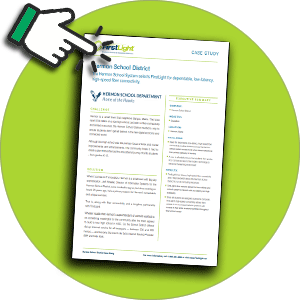
According to Statista, the e-learning market is on pace to top $243 billion worldwide by 2022. Digital curricula that consist of educational software that can be accessed over the Internet are part of this growing market.
The software provides class materials along with student tracking and classroom management capabilities. A digital curriculum can be used to either anchor or supplement a lesson plan. Not only does a digital curriculum make teachers’ lives easier, but it also gives K-12 students access to lesson plans in specialized topics, such as career preparation, computer literacy, and the health sciences.
Digital curricula help students develop crucial computer skills and gain proficiency in STEM topics. However, K-12 schools need the right network infrastructure to make the curriculum work.
 Leveling the Playing Field in Education
Leveling the Playing Field in Education
Using a digital curriculum is a great way for K-12 educators to expose students to learning experiences they might otherwise miss out on. Small schools or those located in rural areas can use the software to teach students about topics outside of the typical curriculum.
With a digital curriculum, students have a better chance of being prepared for college or STEM fields, such as healthcare or IT, by gaining access to top experts in those fields. However, not all schools have the right networking capabilities to take advantage of this opportunity. Without a high-speed, low latency network and enough bandwidth, schools can’t provide reliable access to a digital curriculum
Laying the Foundation for a Digital Curriculum
If the digital curriculum doesn’t work effectively, teachers and schools won’t adopt the technology. Students shouldn’t experience buffering during a lesson. They shouldn’t try to open a learning module only to find that Internet access is down. The ideal network platform must be in place in order for schools to take full advantage of a digital curriculum.
K-12 schools need to use a high-speed, low-latency network to benefit from a digital curriculum. Fiber optic networks provide the speed and performance required by educational applications. With optimally designed fiber optic-based connections, video is clear and audio is jitter free. Fiber optic cables are also resilient and capable of supplying virtually unlimited bandwidth.
 Network Reliability
Network Reliability
Network management is key to maintaining reliable network access to a digital curriculum. Students are only in the classroom for a certain number of hours each day and a certain number of days per year. Teachers can’t afford to waste a minute of class time.
The local area network (LAN) or wide area network (WAN) must provide always-on availability for students and teachers so they don’t fall behind in their work. LAN and WAN management may be too much for the K-12 school to take on, so it’s important to find a provider who will also manage the network.
LAN and WAN management should monitor and report on network status, diagnose and solve any problems, and detect and defend against any security threats.
A big part of having a reliable network means ensuring it is secure. Next generation firewall with content filtering, a Distributed Denial-of-Service (DDoS) mitigation solution, and encrypted wavelength are all options that institutions should consider in ensuring their networks are protected and stable.
Making a Digital Curriculum Affordable
Many schools face financial challenges when trying to implement a high-speed network. Budgets are tight, and K-12 schools need to prioritize expenses.
That’s why the FCC’s E-Rate program is so important. The E-Rate program awards funds to U.S. schools so they can afford telecommunication and Internet services. With E-Rate funds, schools can support a digital curriculum with a state-of-the-art network.
FirstLight is proud to participate in the E-Rate program, allowing K-12 schools in the Northeast region to use distance learning applications to enhance the educational experience. We provide affordable wide area networking (WAN), high-speed internet, and telecommunications solutions for schools so they can leverage online learning opportunities.
Read the story of how FirstLight helped a school in Bangor, Maine get on pace with digital education. Check out our case study.





















